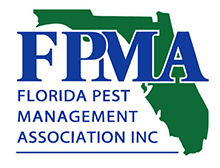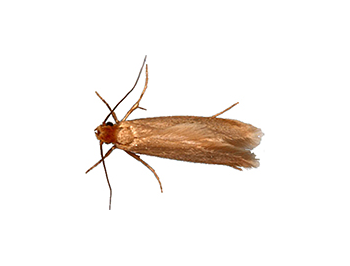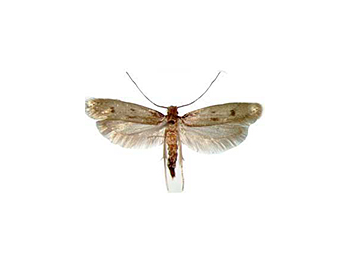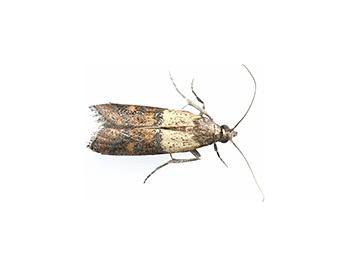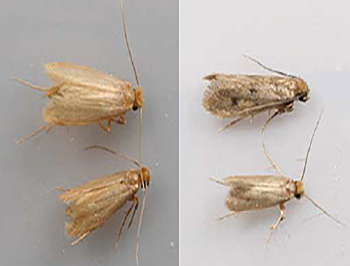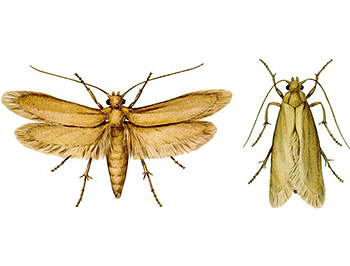Moths
Moths typically have two pairs of wings and large compound eyes but vary dramatically in size and appearance. Some are large and others are tiny and colors can vary from brilliant metalic colors to drab browns and greys, but most indoor infesting moths we deal with are smaller than 2 cm wingspan and often are shades of grey or brown to reddish brown.
The webbing clothes moth is the most commonly encountered fabric moth. The adult is gold with reddish-golden hairs on the top of its head. A row of golden hairs fringes its wings, which have a span of about 1/2 inch. Typically they are only about 1/4 inch long. Because these moths are weak flyers (their flight pattern is distinctive—they tend to flutter about rather than fly in a direct, steady manner) that aren't attracted to lights, you'll usually find them close to infested items, such as in a dark area of the attic or closets. Since moths can be found in the folds of fabrics or hiding in corners and are capable of infesting a home long before their populations are noticed. As a result, substantial damage can occur to clothing or furnishings.
The casemaking clothes moth is similar in size and appearance to the webbing clothes moth, although the wings of the casemaking clothes moth are more brownish and have faint dark-colored spots. The casemaking clothes moth is less common and also of far less economic importance than the webbing clothes moth.
Clothes moths might initially establish themselves on woolen items stored improperly for long periods. Materials which are readily infested include sweaters, coats, upholstery, piano felts, silk, hair, fur, feathers, cottton, linen, blankets and any other woolen products. Synthetic fibers and cellulose materials are damaged only incidentally, often because they are soiled with greasy food stains, body oils, or other residues which are the primary object of the insect attack.
To inspect for clothes moths, look to see if there are silken tubes in the hidden portions of clothes, such as under collars, or silken mats or patches on material. Both the silken tubes and mats often have fibers and feces incorporated into them.
Food-infesting moths fly in a more direct, steady manner. Food-infesting moths also don't have the little tufts of hair on their heads. Such stored foods as meat, fish, meal, bran, semolina and flour (possibly preferring wheat flour) and milk products are vulnerable to these insects.
These moths come in a variety of types, but are usually frequenting your pantry or kitchen cabinets, pet food, or garbage can.
If not properly managed, the larvae of these pests will cause serious damage.
Continuous, Long-Term Protection for Your Home - And Your Peace of Mind
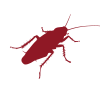
Pest Control Services
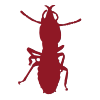
Termite Treatment
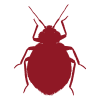
Bed Bug Treatment
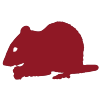
Rodent Control
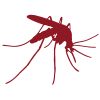
Mosquito Control
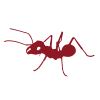
Ant Control
WHAT WE CAN DO FOR YOU
- Personalized excellent "live" customer service.
- Minimize your pest problem for good.
- Increase the value to your business.
- We are State Licensed. Bonded & Insured - saves you money
- We are a local, family-owned business with a wide range of experience devoted to sustainable environmental health
- Monthly, quarterly, yearly special services as needed
PEST CONTROL SERVICES INCLUDE
- Identification and treatment for the existing pest problem We will visit your home to determine the extent of your current pest infestation and locally treat infested areas.
- Perimeter treatment On our first visit, we will perform interior and exterior perimeter treatments to prevent further infestation.
- Quarterly treatment thereafter, we service your home every 3 months including an exterior perimeter treatment.
- Customized services available including monthly and yearly treatments.
WHO WE ARE
Shumaker's Pest Control is a family-owned company utilizing the best practices in the industry and exceeding each of our client’s expectations by providing exceptional quality and personal service.
We would welcome the opportunity to earn your trust and deliver you the best service Shumaker's Pest Control has to offer.
PROFESSIONAL ASSOCIATIONS

